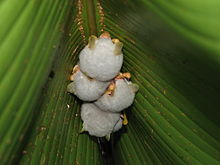| Honduran white bat | |
|---|---|

| |
| A roosting colony (Costa Rica) | |
| Scientific classification | |
| Domain: | Eukaryota |
| Kingdom: | Animalia |
| Phylum: | Chordata |
| Class: | Mammalia |
| Order: | Chiroptera |
| Family: | Phyllostomidae |
| Genus: | Ectophylla H. Allen, 1892 |
| Species: | E. alba
|
| Binomial name | |
| Ectophylla alba H. Allen, 1892
| |

| |
| Range map of the species | |
The Honduran white bat (Ectophylla alba), also called the Caribbean white tent-making bat,[2] is a species of bat in the family Phyllostomatidae. It is the only member of the genus Ectophylla. The genus and the species were both scientifically described for the first time in 1892. It has distinctive, entirely white fur, which is only found in six of the roughly 1,300 known species of bat. It constructs "tents" out of understory plant leaves by strategically cutting the leaf ribs with its teeth; it roosts in these tents during the day. It is a specialist frugivore, consuming almost exclusively the fruits of one species of fig. Females can likely become pregnant twice per year, giving birth to one offspring at a time.
It is found in Honduras, Nicaragua, Costa Rica and western Panama at elevations from sea level to 700 m (2,300 ft).[1] Due to habitat loss, it is evaluated as near-threatened by the IUCN. Its bright yellow ears, nose-leaf, and lips are a result of carotenoid deposition; the mechanism of this deposition is being researched as a way to understand and combat macular degeneration in humans.
- ^ a b Rodriguez, B. and Pineda, W. (2015). "Ectophylla alba". IUCN Red List of Threatened Species. 2015: e.T7030A22027138. doi:10.2305/IUCN.UK.2015-4.RLTS.T7030A22027138.en. Retrieved 19 November 2021.
{{cite journal}}: CS1 maint: multiple names: authors list (link) - ^ Cite error: The named reference
Gillam 2013was invoked but never defined (see the help page).
